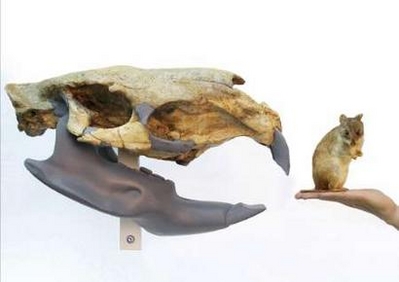Scientists discover huge extinct rodent
Updated: 2008-01-17 09:24
 |
|
The skull of a newly found 2,000 pound (1,000 kg) rodent (L) is shown in comparison to a rat in this handout picture released by the Royal Society Journals on January 16, 2008. Scientists in Uruguay have found the fossil remains of the rodent that lived 2 million to 4 million years ago -- the largest rodent ever found. [Agencies] |
LONDON -- Eeek! Imagine a rodent that weighed a ton and was as big as a bull. Uruguayan scientists say they have uncovered fossil evidence of the biggest species of rodent ever found, one that scurried across wooded areas of South America about 4 million years ago, when the continent was not connected to North America.
A herbivore, the beast may have been a contemporary, and possibly prey, of saber-toothed cats -- a prehistoric version of Tom and Jerry.
For those afraid of rodents, forget hopping on a chair. Its huge skull, more than 20 inches long, suggested a beast more than eight feet long and weighing between 1,700 and 3,000 pounds.
Although British newspapers variously described it as a mouse or a rat, researchers say the animal, named Josephoartigasia monesi, actually was more closely related to a guinea pig or porcupine.
"These are totally different from the rats and mice we're accustomed to," said Bruce Patterson, the curator of mammals at the Field Museum in Chicago, adding that it was the biggest rodent he had ever heard of.
An artist's rendering showed a creature that looked like a cross between a hippopotamus and guinea pig.
The fossil was found in 1987 about 65 miles west of the capital of Montevideo, near the vast River Plate estuary -- a muddy waterway separating Uruguay from Argentina that empties into the South Atlantic. That area is site of ancient riverbanks and other deposits where fossils have been found, he said.
An Argentine fossil collector identified as Sergio Viera donated the skull to Uruguay's National History and Anthropology Museum nearly two decades ago, said museum director Arturo Toscano.
It spent years hidden away in a box at the museum and was rediscovered by curator Andres Rinderknecht, who enlisted the help of fellow researcher Ernesto Blanco to study it.
Blanco told The Associated Press he was shocked when he first came face to face with the fossil, saying it looked even bigger than a cow skull.
"It's a beautiful piece of nature," he said in an interview. "You feel the power of a very big animal behind this."
|
|
|
||
|
||
|
|
|
|

